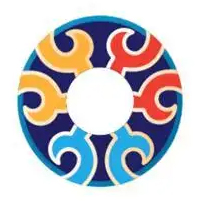Cloisonné - Un trésor de Beijing
Jingtailan is a unique craft in Beijing, known for its magnificent and elegant, and has a high reputation at home and abroad. Jingtailan products are one of the representative works of Jingtailan craftsmanship since the founding of the People's Republic of China, with their unique shapes, patterns, colors, and exquisite processing techniques.
"Peacock Teapot"
"Peacock Teapot" is one of the representative works of Jingtailan products. It features a peacock as its image, with a unique and vivid overall teapot shape. The spout is modeled after the head and neck of a peacock, decorated with traditional fish scale brocade patterns and innovative feather brocade patterns. The mouth, lid, and base of the teapot are adorned with beautiful decorations, with smooth lines that leave a lasting impression. The top cover knob is shaped like two metal peacocks in an open screen shape, fully showcasing the superior level of Jingtailan artistry. The glaze colors are primarily coral red, complemented by blue-green and gold, creating a harmonious and elegant appearance.
Vase Rangcao Peony Pattern Enamel Enroulement de fil
Ce travail en cloisonné de la fin de la dynastie Qing est maintenant conservé au Musée du Palais. Les fleurs de pivoine peintes sur le vase ont un fort effet tridimensionnel, donnant un effet visuellement prominent. Le motif de pivoines entrelacées est un motif décoratif populaire dans les dynasties Ming et Qing, avec les branches de pivoine sur l'image étant tordues en lignes ondulées continues, décorées de feuilles de fleurs. Ce vase est émaillé en jaune, avec des fleurs de pivoine entrelacées et des chauves-souris rouges. Les pivoines entrelacées et les chauves-souris symbolisent ensemble la grande fortune et la prospérité continue. Il y a deux dragons enroulés sur l'épaule de ce vase, qui sont des symboles du pouvoir impérial et aussi les caractéristiques de l'émail cloisonné impérial.
Brûleur d'encens tripode avec motif de lotus entrelacé
Cette émail du Yuan Dynasty est une collection du Palais Qing et est maintenant abritée dans le Musée du Palais National de Taipei. Le four est rond avec des poignées doubles et un corps en forme de tambour, ressemblant à un trépied en bronze, simple et solennel. La partie supérieure du corps du four est divisée en deux parties par un motif de fil doré. La partie supérieure du corps du four est émaillée en vert avec 12 chrysanthèmes blancs. La partie inférieure est émaillée en bleu avec 6 motifs de fleurs de lotus entrelacées. Les trois pieds sont tous en émail bleu avec des motifs de chrysanthèmes colorés. Le motif décoratif présente des fleurs de lotus entrelacées qui s'épanouissent, avec des lignes audacieuses et puissantes, une texture d'émail délicate et propre, et un émail brillant. Ce four est une œuvre représentative de l'émail du Yuan Dynasty.
Conteneur à vin floral avec motif de fleurs et feuilles en forme de spatule
This Ming Dynasty flowerpot is in three sections, with a blue enamel glaze and decorated with colorful intertwined lotus patterns. The flowerpot has a simple and elegant shape, with smooth lines and vibrant colors. It was originally a decoration in the Ming Dynasty imperial study, modeled after Shang and Zhou bronze vessels, with a refined color scheme. It was previously converted into a table lamp, with a hole punched in the bottom. The original inscription of 'Jingtai year made' on the bottom of the flowerpot is partially damaged due to the punched hole. This artwork embodies the simple beauty of the flowerpot and the exquisite craftsmanship of Ming Dynasty imperial cloisonné enamel.
Vase Tianji
This Jingtailan artwork from the Qing Qianlong period features an image of a proud and upright Tianji. It carries a chi-ear vessel on its back, with spread wings attached to the body, and a pair of hollow double wheels on the footrest. The long tail hangs down and curls inward, with a small Tianji with copper-gilt feathers standing on the inner side of the tail. The chest of the Tianji is adorned with cloud-shaped enamel decorations, with a rectangular copper-gilt plaque embedded in the middle, engraved with the inscription 'Made in the Qianlong reign'. The overall piece is made of red copper, with cloisonné patterns filled with enamel colors and gilded copper exposed. This artwork has a beautiful shape and rich colors, showcasing the exquisite craftsmanship in cloisonné production during the Qianlong period.
Pot à soulever avec motif de visage de bête
This is a lifting pot made during the Qianlong period of the Qing dynasty, enameled in blue with filigree patterns. A beast face is decorated on the center of the neck's front and back, flanked by flying phoenixes; the belly is adorned with double phoenixes flying towards each other. This pot has an ancient and beautiful shape, smooth lines, and brilliant colors. The surface of the pot also features the sunken-engraved characters 'Made in the Qianlong Year'. This pot reflects the exquisite level of filigree enamel craftsmanship in the middle of the Qing dynasty.

